Home improvement giant Home Depot (HD) may have an advantage that few, if any, have really considered yet. That advantage is called “reverse logistics,” and may suggest that Home Depot has a better supply chain than you might expect. That news should have been more welcome for Home Depot investors, but as it turns out, shares of Home Depot were down fractionally in Thursday afternoon’s trading.
Elevate Your Investing Strategy:
- Take advantage of TipRanks Premium at 50% off! Unlock powerful investing tools, advanced data, and expert analyst insights to help you invest with confidence.
Home Depot took to the stage at the CSCMP EDGE 2025 Conference and came with one key point in mind: reverse logistics. So what are “reverse logistics,” and why are they opening up a big new advantage for Home Depot? Based on what I could find, reverse logistics are basically exactly what the name implies: logistics that run in reverse. That means very little by itself, so more specifically, it means a logistics process that starts with the end customer returning something.
Products that get damaged in a warehouse and get returned to the supply chain, or products that get liquidated, or even the things that customers return for one reason or another become part of the reverse logistics train. By effectively managing reverse logistics, the system has less waste and can operate more efficiently. That in turn means less loss and more resources that can be more effectively used elsewhere in the system. So for Home Depot to effectively manage reverse logistics, it gets an improvement to its overall supply chain system and potentially an advantage over its competitors.
Dual Focus
Meanwhile, others are taking notice of Home Depot’s split focus between the pro builder market and the do-it-yourself (DIY) market. With sales on the rise, up 4.9% in the second quarter of fiscal 2025 against the second quarter of fiscal 2024, there are some clear benefits to this strategy as consumer demand is making at least something of a comeback in the home improvement space and the pro builder market is bringing its own value in as well.
With Home Depot able to work effectively in both fields, that is giving it another advantage in the field, and giving its competitors one more reason to be deeply concerned.
Is Home Depot a Good Long-Term Buy?
Turning to Wall Street, analysts have a Strong Buy consensus rating on HD stock based on 19 Buys and six Holds assigned in the past three months, as indicated by the graphic below. After a 6.38% loss in its share price over the past year, the average HD price target of $446.30 per share implies 17.39% upside potential.

















